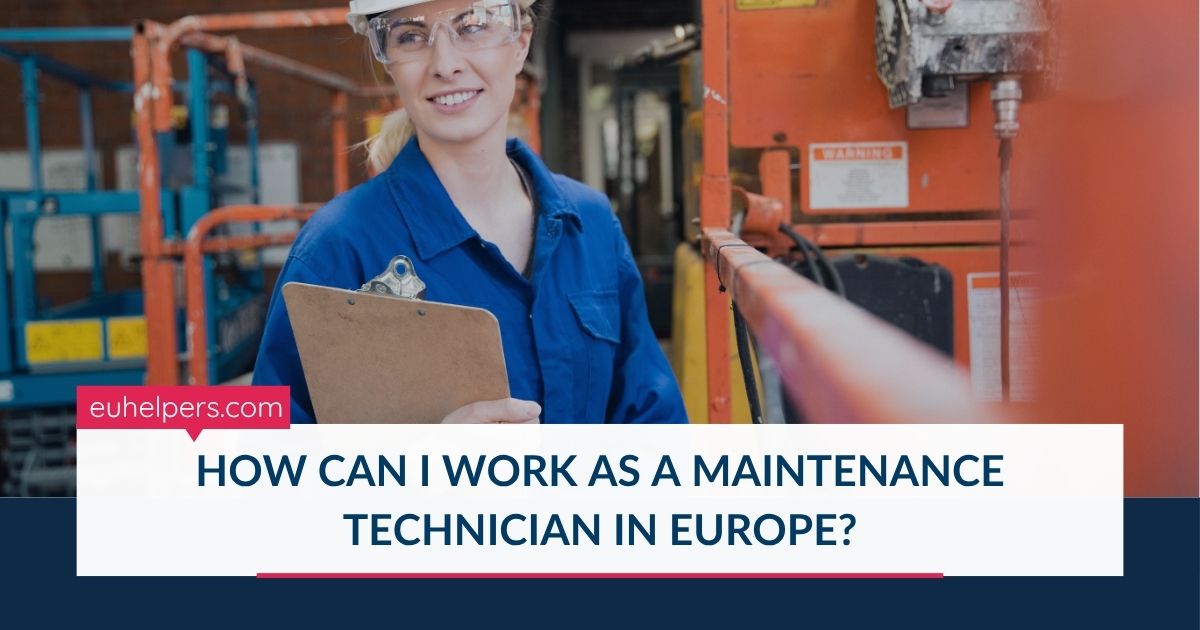
Europe offers tremendous opportunities for skilled workers, and maintenance technicians are among the most sought-after professionals across various industries. From factories and manufacturing plants to hotels, hospitals, and construction sites, the demand for qualified maintenance technicians has been steadily growing. If you have the technical skills and are looking to build a stable, rewarding career in Europe, this guide will walk you through every step — from qualifications to visa requirements.
Understanding the Role of a Maintenance Technician
A maintenance technician is responsible for the upkeep, repair, and inspection of machinery, buildings, and equipment. The role varies depending on the industry, but generally includes tasks such as:
-
Inspecting and repairing electrical, plumbing, or mechanical systems
-
Conducting routine maintenance checks
-
Diagnosing system malfunctions and fixing breakdowns
-
Ensuring safety standards and regulations are met
Industries hiring maintenance technicians in Europe include:
-
Manufacturing and industrial production
-
Hospitality (hotels and resorts)
-
Healthcare (hospitals and clinics)
-
Energy and utilities
-
Transportation and logistics
Step 1: Gain the Necessary Qualifications
To work as a maintenance technician in Europe, you typically need:
-
A technical diploma or vocational certificate in mechanical, electrical, or industrial maintenance.
-
Practical work experience in repair, maintenance, or engineering.
-
Basic knowledge of safety standards and preventive maintenance practices.
For specialized positions, employers may require additional training or certifications such as:
-
HVAC Certification (for heating and cooling systems)
-
PLC Programming Skills (for industrial automation)
-
Electrical Safety or Machinery Maintenance certifications
Step 2: Learn the Language
While English is widely used in European workplaces, knowledge of the local language can significantly increase your chances of being hired.
-
For Germany or Austria, learn German.
-
For France or Belgium, basic French is useful.
-
For Spain or Italy, learning Spanish or Italian can open more doors.
Some employers may even provide language training to foreign workers before or after arrival.
Step 3: Prepare Your Resume and Certifications
Your resume (CV) should highlight your technical expertise, certifications, and relevant experience. Include:
-
Technical qualifications and training
-
Hands-on experience with tools, machinery, and maintenance systems
-
Knowledge of safety standards (like ISO or OSHA)
-
Language skills
It’s also helpful to prepare translated copies of your certificates (in English or the language of your target country).
Step 4: Find Job Opportunities in Europe
Maintenance technicians are in high demand across the EU, and there are multiple ways to find a job:
Top Job Portals:
-
EURES Portal (ec.europa.eu/eures) – Official EU job mobility platform
-
Indeed Europe, LinkedIn, and Glassdoor
-
Specialized recruitment agencies like Adecco, Manpower, and Randstad
Countries with high demand:
-
Germany – Industrial and manufacturing sectors
-
Netherlands – Logistics and machinery industries
-
Poland – Automotive and production plants
-
France – Hotels and maintenance companies
-
Sweden and Denmark – Energy and mechanical sectors
Step 5: Get a Work Visa or Permit
If you are from outside the EU/EEA, you will need a valid work visa. The type of visa depends on the country you wish to work in.
Common visa options:
-
EU Blue Card – For highly skilled workers in engineering and technical fields.
-
National Work Visa – Issued by individual European countries (like Germany or France).
-
Seasonal or Temporary Work Visa – For short-term contracts in maintenance or technical support roles.
General visa requirements include:
-
Valid passport
-
Job offer or employment contract from a European employer
-
Proof of qualifications and experience
-
Proof of sufficient funds and health insurance
Step 6: Obtain Worksite Certifications
Before starting your job, you may need specific certifications depending on the country and industry. For example:
-
VCA Certification (Netherlands/Belgium) – Safety standards for technicians.
-
CSCS Card (UK) – Required for work in construction-related maintenance.
-
GWO Certification (Denmark/Germany) – For working in wind energy or offshore industries.
These certifications show that you meet safety and operational standards in Europe.
Step 7: Move and Settle in Europe
Once your visa is approved, plan your relocation.
-
Arrange accommodation (some employers provide housing).
-
Apply for a tax ID number and health insurance.
-
Open a bank account for salary deposits.
Many companies also offer onboarding programs for foreign workers, making it easier to adapt to your new environment.
Benefits of Working as a Maintenance Technician in Europe
-
High salaries compared to other regions
-
Stable employment and career progression opportunities
-
Paid leave, healthcare, and pension benefits
-
Exposure to advanced technologies and safety systems
-
Opportunity to apply for permanent residency after a few years
Working as a maintenance technician in Europe can be an excellent career move for skilled professionals. The combination of strong job demand, competitive pay, and long-term career prospects makes this field one of the most promising for international workers. Focus on obtaining recognized technical certifications, improving your language skills, and applying for visa sponsorship roles — and you’ll be well on your way to starting your European career.
